East German coins price guide - (1948-1990)
Total added coins: 395

Prices of coins GDR

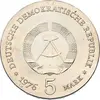

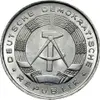
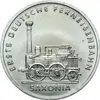

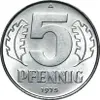

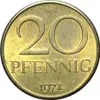





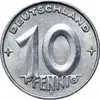
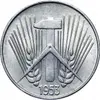




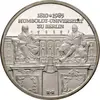


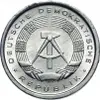
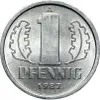
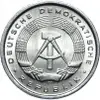

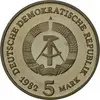


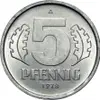
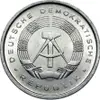


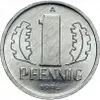




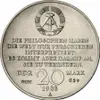







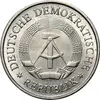


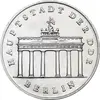
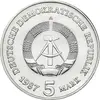
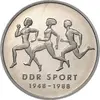
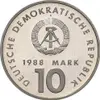







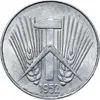


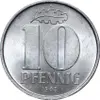
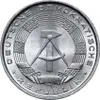
















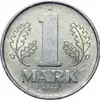
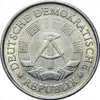
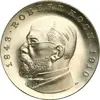
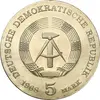



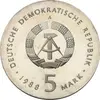


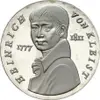
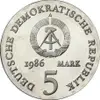
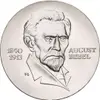

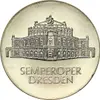

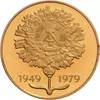
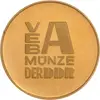
Coins of the German Democratic Republic
Historical review
Since the end of the World War II, Germany was divided by the Allies into four occupation zones. The Federal Republic of Germany was composed of three western zones, while the German Democratic Republic (GDR) or East Germany was founded in the Soviet-occupied zone in the east in 1949. The GDR considered itself a Marxist-Leninist state of workers and farmers and a German state of peace (Friedensstaat).
A non-democratic system and supply shortages led to mass discontent and outflow of highly qualified specialists. To counteract this threat to its existence, the Berlin Wall was constructed in 1961. The rest of the border with the Federal Republic of Germany was also tightly closed.
In the 1980s, criticism of the regime grew among the GDR population. The reasons were many and varied: restriction on movement, ubiquitous surveillance by Stasi, supply shortages, electoral fraud etc. Reforms carried out by Mikhail Gorbachev in the Soviet Union gave hope that changes may occur in the GDR too. However, the Socialist Unity Party (SED) led by its leader Erich Honecker, vehemently rejected any reforms.
In 1989, open protests broke out and were not suppressed anymore. In the end, these protests enhanced by waves of emigration through Hungary and Czechoslovakia led to the peaceful fall of the Berlin Wall and ultimate downfall of the GDR. German reunification took place in 1990.
Coins of the East Germany
The first coins were minted in the GDR in 1948, even before the state was officially founded. They had the values of 1, 5 and 10 pfennigs and were made of aluminum. Later, 50- and 20-pfenings made of copper alloys were added. From 1956 to 1957, 1- and 2-marks coins were also minted in aluminum.
In addition to coins intended for everyday circulation and payments, the GDR also issued a large number of commemorative coins with the value of 5, 10 and 20 marks. They were made of silver or the so-called Neusilber, or German silver (copper alloy with nickel), and reflected political, cultural and historical motifs of the GDR. Commemorative coins were not intended for circulation but were mostly sold at higher prices to collectors in the West. It was thus an important source of foreign exchange revenues for the GDR.
The GDR minted its coins in Berlin (coins marked with letter A) and, only till 1953, in Muldenhütten (coins marked with letter E). The stocks of eastern marks available in the Federal Republic of Germany and western countries were a problem for the GDR authorities. Therefore, it carried out a currency conversion in 1957, which devalued these stocks.
In 1964, the GDR mark was renamed into the mark of the German Central Bank (Mark der Deutschen Notenbank, abbreviated as MDN). From 1966, the GDR each year issued a few commemorative coins made of neusilber or silver. They were denominated in 5, 10 and 20 marks. By the end of the GDR, a total of approx. 60 silver coins (10- and 20-marks) and more than 80 neusilber coins (5-, 10- and 20-marks) were minted. These coins had various styles, proof finishes (PP), off-strikes in various metals, patterns and variants. Here are some of the most valuable coins:
- 10 marks, 1974, 25th Anniversary of the GDR, proof finish (mintage: 200);
- 10 marks, 1974, 200th birthday of Caspar David Friedrich, proof finish (mintage: 100);
- 20 marks, 1975, 225th anniversary of Johann Sebastian Bach’s death, proof finish (mintage: 3);
Two 10-marks items are regularly sold at auctions for several thousand euros. 20-marks coins are hardly available on the market due to their extremely small mintage. The standard catalogue for German coins by Kurt Jäger estimates the value at €20,000 (edition No. 27, 2021).
Initially, silver coins of the GDR had the purity of 800/1000 till 1968, afterwards it was 625/1000 till 1976, and finally 500/1000 till 1990. There were five exceptions during the period from 1986 to 1990 applied to the following 20-marks coins having the purity of 625/1000:
- 20 marks, 1986, Grimm brothers;
- 20 marks,1987, 750th anniversary of Berlin;
- 20 marks, 1988, Carl Zeiss;
- 20 marks, 1989, Thomas Müntzer;
- 20 marks, 1990, Andreas Schlüter.
The last silver coin of the GDR — 20 marks — issued in 1990 and devoted to the opening of the Brandenburg Gate was made of pure silver (999.5/1000). Golden coins were never issued in the GDR.
After the German reunification, the GDR’s money lost its validity.
Coins of the GDR are fascinating pieces of collecting having both historical and cultural value and are popular with collectors worldwide.
Heinrich Hegen

